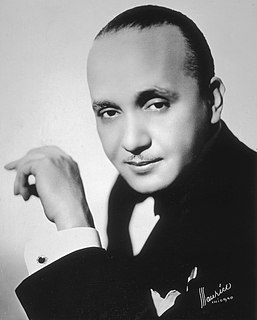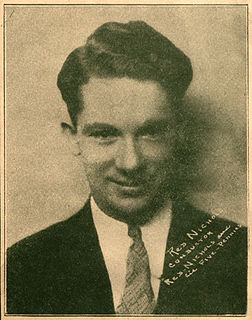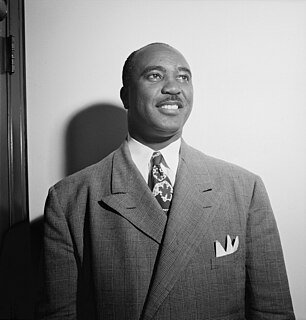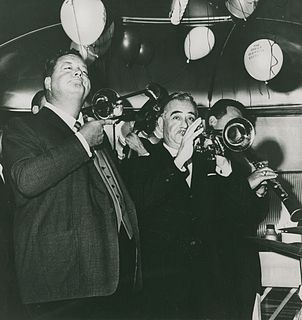Related Research Articles

The Original Dixieland Jass Band (ODJB) was a Dixieland jazz band that made the first jazz recordings in early 1917. Their "Livery Stable Blues" became the first jazz record ever issued. The group composed and recorded many jazz standards, the most famous being "Tiger Rag". In late 1917 the spelling of the band's name was changed to Original Dixieland Jazz Band.

Lionel Leo Hampton was an American jazz vibraphonist, pianist, percussionist, and bandleader. Hampton worked with jazz musicians from Teddy Wilson, Benny Goodman, and Buddy Rich, to Charlie Parker, Charles Mingus, and Quincy Jones. In 1992, he was inducted into the Alabama Jazz Hall of Fame, and he was awarded the National Medal of Arts in 1996.

Edward "Kid" Ory was an American jazz trombonist and bandleader. He was born on Woodland Plantation, near LaPlace, Louisiana.

Jimmie Noone was an American jazz clarinetist and bandleader. After beginning his career in New Orleans, he led Jimmie Noone's Apex Club Orchestra, a Chicago band that recorded for Vocalion and Decca. Classical composer Maurice Ravel acknowledged basing his Boléro on an improvisation by Noone. At the time of his death Noone was leading a quartet in Los Angeles and was part of an all-star band that was reviving interest in traditional New Orleans jazz in the 1940s.

James Fletcher Hamilton Henderson was an American pianist, bandleader, arranger and composer, important in the development of big band jazz and swing music. He was one of the most prolific black musical arrangers and, along with Duke Ellington, is considered one of the most influential arrangers and bandleaders in jazz history. Henderson's influence was vast. He helped bridge the gap between the Dixieland and the swing eras. He was often known as "Smack" Henderson.

Ernest Loring "Red" Nichols was an American jazz cornetist, composer, and jazz bandleader.

James Melvin Lunceford was an American jazz alto saxophonist and bandleader in the swing era.

Bennett Lester Carter was an American jazz saxophonist, clarinetist, trumpeter, composer, arranger, and bandleader. With Johnny Hodges, he was a pioneer on the alto saxophone. From the beginning of his career in the 1920s, he worked as an arranger including written charts for Fletcher Henderson's big band that shaped the swing style. He had an unusually long career that lasted into the 1990s. During the 1980s and '90s, he was nominated for eight Grammy Awards, which included receiving a Lifetime Achievement Award.

Irving Milfred Mole, known professionally as Miff Mole was a jazz trombonist and band leader. He is generally considered one of the greatest jazz trombonists and credited with creating "the first distinctive and influential solo jazz trombone style."

Omer Victor Simeon was an American jazz clarinetist. He also played soprano, alto, and baritone saxophone and bass clarinet.

Marvin E. Ashbaugh was an American jazz pianist.
The Original Memphis Five was an early jazz quintet founded in 1917 by trumpeter Phil Napoleon and pianist Frank Signorelli. Jimmy Lytell was a member from 1922 to 1925. The group made many recordings between 1921 and 1931, sometimes under different names, including Ladd's Black Aces and The Cotton Pickers. Richard Cook and Brian Morton, writing for The Penguin Guide to Jazz, refer to the group as "one of the key small groups of the '20s".

Phil Napoleon was an early jazz trumpeter and bandleader born in Boston, Massachusetts. Ron Wynn observed that Napoleon "was a competent, though unimaginative trumpeter whose greatest value was the many recording sessions he led that helped increase jazz's popularity in the mid-'20s." Richard Cook and Brian Morton, writing for The Penguin Guide to Jazz, refer to Napoleon as "a genuine pioneer" whose playing was "profoundly influential on men such as Red Nichols and Bix Beiderbecke."

William C. "Buster" Bailey was a jazz clarinetist.
James Louis Blythe was an American jazz and boogie-woogie pianist and composer. Blythe is known to have recorded as many as 300 piano rolls, and his song "Chicago Stomp" is considered one of the earliest examples of boogie-woogie music to be recorded.

Arthur Budd Scott was an American jazz guitarist, banjoist and singer. He was one of the earliest musicians associated with the New Orleans jazz scene. As a violinist he performed with James Reese Europe's Clef Club Orchestra at a historic 1912 concert at Carnegie Hall, and the following year worked with Europe's ensemble on the first jazz recordings on the Victor label.
Johnny Mince was an American swing jazz clarinetist.

James "Rosy" McHargue was an American jazz clarinetist, associated principally with the Dixieland jazz scene.
Joseph Anthony (Fud) Livingston was an American jazz clarinetist, saxophonist, arranger, and composer. He co-wrote the jazz and pop standard "I'm Thru With Love".

Paul Specht was an American dance bandleader popular in the 1920s.
References
- ↑ Scott Yanow, Jimmy Lytell at Allmusic
- ↑ Joseph F. Clarke (1977). Pseudonyms. BCA. p. 106.